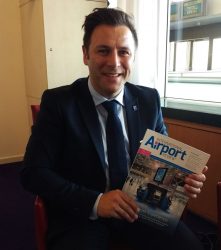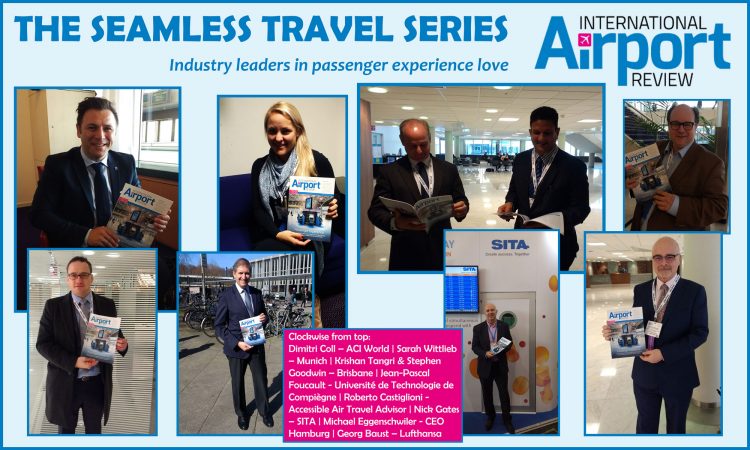Understanding the airport passenger with ACI World’s unique survey
- Like
- Digg
- Del
- Tumblr
- VKontakte
- Buffer
- Love This
- Odnoklassniki
- Meneame
- Blogger
- Amazon
- Yahoo Mail
- Gmail
- AOL
- Newsvine
- HackerNews
- Evernote
- MySpace
- Mail.ru
- Viadeo
- Line
- Comments
- Yummly
- SMS
- Viber
- Telegram
- Subscribe
- Skype
- Facebook Messenger
- Kakao
- LiveJournal
- Yammer
- Edgar
- Fintel
- Mix
- Instapaper
- Copy Link
Posted: 12 April 2017 | Dimitri Coll | Head ASQ | ACI World, Roy Manuell, Digital Editor | No comments yet
We bring you an exclusive interview with Head of ASQ at ACI World, Dimitri Coll as we discuss how airports can radically improve their understanding of passengers.


The conversation has shifted. The air passenger now expects a seamless experience from door to door. The challenge for airports is ensuring the satisfaction of the new demands of the modern passenger. How might this be achieved? International Airport Review‘s Roy Manuell spoke to Dimitri Coll, Head, Airport Service Quality (ASQ), ACI World while at Passenger Terminal Expo earlier in March to discuss the innovative solution ACI World is presenting to airports across the globe.
What is the ASQ survey?
In essence, the ASQ Survey provides a rating for the performance of an airport in 34 of the key service areas in order to provide a global comparison standard for airports.
The survey ultimately gauges passenger satisfaction when travelling through a particular airport while they are physically in the airport itself. This ensures that passengers are instinctive in the responses they give. ASQ surveys are currently conducted at over 320 airports worldwide, covering more than half of the world’s 7.1 billion annual passengers and more than 75% of the world’s 100 top airports are currently ASQ Survey members. The survey itself is designed to be flexible and its coverage ranges from some of the world’s smallest commercial airports to the mega-hubs.
The multilingual survey is for ACI Member airports and measures the on-the-day experience of some 550,000 passengers worldwide and is split into eight major categories such as: Access, check-in, security, airport facilities and food and beverage providers.
The survey’s overarching aim? The creation of an industry standard from which all airports can be measured, analysed and benchmarked against others across the world.
For more information, we invite you to look at the ASQ website.
What is the principle message we need to get across regarding passenger experience and airports?
The message is pretty clear. In order to obtain a full picture of precisely what passenger experience represents and how it might be improved, it is not enough to simply know the passenger. You have to understand them. The best way to do this is by implementing the ASQ survey. Based upon this, at the ACI ASQ team, we have developed what we call passenger personas. Consequently, we have created a set of six passenger personas with which we strongly believe we can aid airports to design a much better passenger experience in order to increase non-aeronautical revenue.
If an airport can specifically target the relevant passenger with an experience designed for them, then this inevitably increases their passenger satisfaction. This capacity to design experiences relevant to the individual passenger will be very important moving forward.
So personalisation of experience will become a defining factor in the airport world?
Much like the fact that each airport is unique, each passenger is too. It is of fundamental importance that we understand this. Strategically speaking, it is really important to have a long term vision of this. An airport must have access to necessary passenger information in order to acknowledge what it does well and what it does not. If it has this, then it can either take measures or alternatively ask itself:
What must I do in the next five years to ensure that I can satisfy the passenger personas that currently are not enjoying the best experience possible at my airport?
Each airport is unique… each passenger is too
Some airports may not be able to appease a certain persona, so then it might be more about looking to improve experience for, and target another persona. In short, an increase in passenger satisfaction correlates to an increase in revenue generation and ASQ has published a study to prove this statement. It’s the same in every industry, all over the world. Satisfaction equals revenue.
Why is it particularly important for an airport to do this in the current climate?
Within the ultra-competitive, globalised market, increased revenue generation both aeronautical and non-aeronautical is of primordial importance. Our survey is key to achieving this.
Specifically why is the ASQ survey so useful in this respect?
The survey itself is available in 41 languages so this immediately encourages any type or nationality to respond and is based around the pen and paper format. Nothing over-complicated. A very important aspect of this is the fact that passengers take the survey there and then. The methodology is key and the survey results are not just a useful marketing tool. They provide a deeper understanding. Understanding is the keyword. Passengers are taken from a randomly selected sample and thus representative of the airport’s typical passenger population.
The data is more accurate if the experience is fresh in their mind and not asked 6 months down the line.
The arbitrary nature of the choice is far more useful for an objective profiling of the airport than the information that a self-selection process on the part of the passenger would provide. This is also why we question the passenger on-the-spot so that not only is the experience still fresh, but also the reaction is emotional, instinctive and centred around the details of their experience – three key aspects of passenger experience. It’s not taken two hours later, it’s not two days later – it’s there and then.
The data is more accurate if the experience is fresh in their mind and not asked 6 months down the line. The quality of the data determines the quality of the forward strategic planning. The survey also aims to reach not only passengers but also staff. Sometimes passenger satisfaction is also achieved from the inside out.
So more generally, what are the biggest challenges we face as an industry in the realm of passenger experience?
First of all, it’s not easy for an airport, as airports process both domestic and international passengers – some more than others are more domestically-focused. For me, for a domestic-focused airport ensuring satisfaction is easier. The passenger is by definition heterogeneous – there is not just a single type. The challenge for international airports is to leave a mark on the passenger in the competitive marketplace while processing millions of passengers and ensuring a high quality of passenger experience.
It’s not easy.
Each moment for each passenger is different.
Passenger experience itself is more than just satisfaction as well. It seems very hard for the industry to understand this. Passenger satisfaction is the foundation of passenger experience, but there is so much more to it.
Airports now need to create an emotional link between themselves and passengers and engage them to ensure that they become brand ambassadors themselves. The main challenge is to balance the practical task of processing more and more passengers around the world while creating engagement and an ongoing relationship with and customised experience for each of these individuals.
This is why the ASQ passenger personas are so important. Each moment for each passenger is different. For business travellers, a particular moment within the airport might be far more important and valuable than that of a family travelling on holiday and vice versa. It’s about balancing cost, efficiency and experience with the sheer diversity of the ever-expanding air travel market.
How does this differ around the world?
The passenger’s relationship with an airport differs from continent to continent. For example, in the US, using an airport is like taking the bus. It’s a utility. In other nations, air travel is a luxury, in others it’s part of the experience itself. Ownership also changes around the world from private to public and it is the aim of the ASQ survey to reconcile these regional differences to tailor and personalise experience accordingly.
What sort of role will technology play in all of this?
Technology is not the answer to everything. It is however very important and is now an expectation. For one, technology certainly increases general efficiency but we must be careful to ensure the human touch at the same time. Self-check-in, apps, connectivity for example, all aid towards improving overall passenger experience but often, we find, passengers ultimately want to talk to someone face to face.
I come from an insurance background and say for example, you as a young man or woman are looking to insure your first car or home. You don’t want to do this alone online or using technology – you want to speak to someone face to face who might be able to talk you through this alien process. In future, you might then be able to tackle this process using technology but for first-time users the human touch is key.
Technology will undoubtedly increase efficiency and add value to an airport but there is not a one-size-fits-all approach to approaching passenger experience that technology can provide. The elderly passenger may not wish to be greeted by technology which might appear intimidating to them. Once again, we I want to assert that we need to treat each passenger as an individual.
Airports now need to put themselves in the place of the passenger in order to best design their experience. In our industry, we are often too focused on ourselves as airports, airlines and regulators whereas we now need to truly understand our passengers. This is where the ASQ survey becomes integral to ensuring a seamless experience for all.
It was a please speaking to Dimitri Coll at the ASQ team at Passenger Terminal Expo and for more information about the ASQ, click here.
The Seamless Travel Series so far
The conversation is shifting. It is no longer a question of passenger experience. Air travel is now defined by ensuring seamless travel. In this new online series, International Airport Review will explore different perspectives from industry leaders such as SITA, Munich Airport, ACI World and many more to consider the ways in which the concept of seamless travel is now defining the changing world of air travel.
For an introductory definition of ‘seamless travel’, click here…


Elevating experience at Hamburg – Hamburg CEO Michael Eggenschwiler
Small changes, big differences for PRMs – Roberto Castiglioni, Accessible Air Travel Advisor
Related topics
Aeronautical revenue, Airside operations, Passenger experience and seamless travel, Terminal operations


















